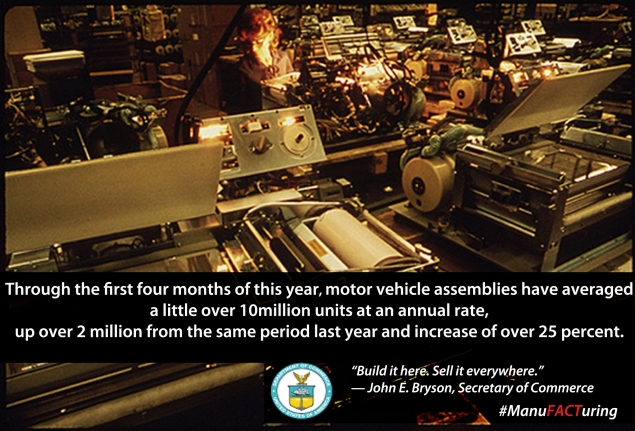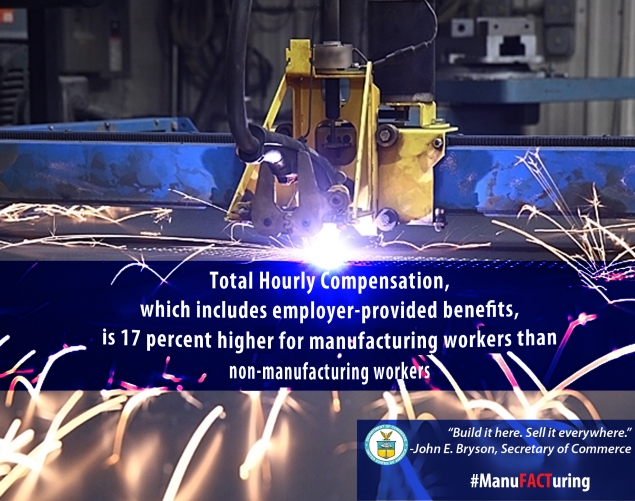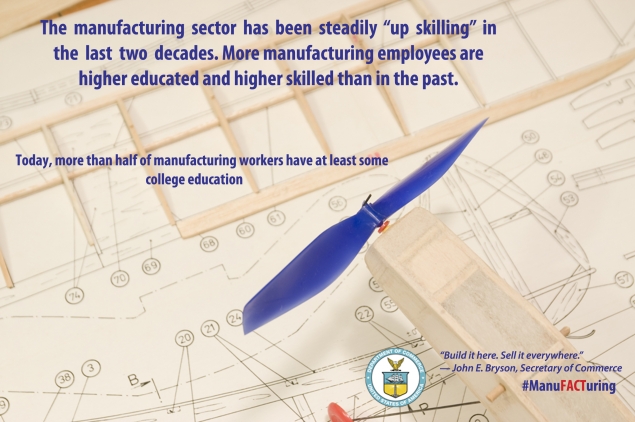This afternoon Chief Economist Mark Doms addressed the 2012 National Association for Business Economics (NABE) Industry Conference, themed “Making it in America: Manufacturing Matters” in Cleveland, OH. Hosted by the Federal Reserve Bank of Cleveland, this NABE industry conference focused on “the changing dynamics and rebalancing of U.S. manufactures in the global economy, focusing on its rejuvenation and new challenges and opportunities.” He previewed an upcoming ESA report showing that many communities depend critically on manufacturing, and these communities are spread all across the United States. That is because manufacturing provides the basis for many middle class jobs with good benefits.
- Much of our country’s innovation comes from the manufacturing sector: close to 70 percent of our research and development and 90 percent of our patents.
- Since the trough of manufacturing employment, firms have added about a half million new jobs.
- The manufacturing industry has been one of the leading contributors to GDP growth over the last two years, accounting for 38 percent of total economic growthIn 2011, the U.S. exported over $1.26 trillion worth of manufactured goods, more than double the amount in 2002. Also, since the trough in 2009, manufactured goods exports are up 38 percent.
- In particular, small and medium sized companies are increasingly contributing to our export growth, and they now make up over a third of total exports.
That is why the Administration’s focus on manufacturing is so important. Doms highlighted what the Commerce Department is doing to help.
- White House Office of Manufacturing Policy: To improve the coordination of manufacturing policy across the federal government, Commerce Secretary John Bryson and National Economic Council Director Gene Sperling co‐chair the White House Office of Manufacturing Policy. Established by the President last year, the office works across federal agencies to coordinate and implement priority manufacturing initiatives.
- National Network for Manufacturing Innovation: In his fiscal year 2013 budget, President Obama proposed creating the National Network for Manufacturing Innovation (NNMI) to strengthen the foundation of U.S. innovation infrastructure with up to 15 competitively-selected regional hubs of manufacturing excellence. Funded by a one-time $1 billion investment, these regional hubs would bring together industry, universities and community colleges, federal agencies, and state partners to accelerate innovation by investing in industrially-relevant manufacturing technologies.
- Advanced Manufacturing National Program Office: In December 2011, U.S. Commerce Secretary John Bryson formed the Advanced Manufacturing National Program Office (AMNPO). Hosted by the Commerce Department’s National Institute of Standards and Technology (NIST), the AMNPO engages with manufacturing businesses, universities, and other federal agencies to implement an integrated “whole of government” advanced manufacturing initiative.
- Manufacturing Extension Partnership: Housed in the Commerce Department’s National Institute of Standards and Technology (NIST), the Hollings Manufacturing Extension Partnership (MEP) is a federal-state partnership with a national network of MEP Centers located in all 50 states and Puerto Rico. Through these centers, more than 1,400 technical experts help small and medium-sized manufacturers connect to public and private resources essential for increased competitiveness and profitability.
Doms also highlighted some of the key findings in a recent report published by the Commerce Department’s Economics and Statistics Administration: The Benefits of Manufacturing Jobs. The report finds that wages and salaries were 8 percent higher in manufacturing than in other industries, and benefits were 59 percent higher. All told, manufacturing enjoys a 17 percent compensation per hour premium over other industries.
















Comments Closed
Due to increased spam, comments have been closed on this content. If you wish to comment about the content, we encourage you to email webmaster@doc.gov.